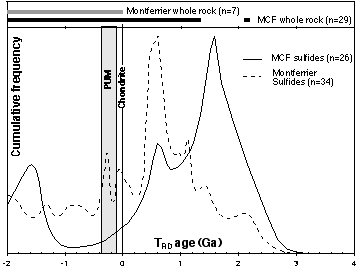Alard O.1, Pearson N.J.1, Reisberg L.2, Lorand J.-P.3, Griffin W.L.1
and O'Reilly S.Y. 1
1. GEMOC, Macquarie, 2. CRPG-CNRS, Nancy-les-Vandoeuvre, France, 3.
Laboratoire de Mineralogie, Museum National d'Histoire Naturelle, Paris,
France
The Re-Os isotopic system has the potential to date the main events of lithosphere formation. Several studies (e.g., Pearson, 1999) of Archean, Proterozoic and Phanerozoic terrains have shown mantle lithosphere Re-depletion ages to be in broad agreement with the age of the overlying crust, suggesting a strong genetic and mechanical link between the two reservoirs. Other Re-Os studies (Peslier et al., 2000) have suggested decoupling between mantle and crust, at least in Proterozoic and younger terrains. The French Massif Central (MCF) and the neighbouring southern volcanic provinces (eg. Montferrier) are rich in peridotite xenoliths, allowing an extensive regional sampling. This lithosphere segment has been extensively reworked during two major orogenies, the Cadomian (=500-600 Ma) and especially the Variscan (350-280 Ma). More recently the lithosphere has been impinged upon by a plume, triggering thermal and chemical erosion, that enhanced sulfide mobility (Lorand et al., 1998, Alard et al., 1998). This sulfide is the main host phase for Os (Alard et al., 2000). The aims of this study are to decipher : (1) whether the mantle lithosphere is decoupled from the crust during major tectonic events such as the Variscan orogeny; (2) the effect on Os systematics of lithosphere-asthenosphere interaction.
Whole-rock 187Os/188Os in MCF and Montferrier xenoliths (n=36) range
between 0.1130 and 0.1756, yielding TRD ages spanning from 1.4 Ga to future
ages. One sample yields a TRD age of about 2.2 Ga. Radiogenic ratios
are obtained for S-rich samples (200<S<600 ppm) while unradiogenic
ratios are obtained for S-depleted samples. Duplicate analyses of
single xenoliths show high variability. Both observations suggest that
unevenly distributed sulfides are the carrier of the radiogenic signature.
Os isotope ratios of silicate-enclosed and interstitial sulfides have been
determined in-situ using a Laser Ablation Microprobe coupled to a Nu-Plasma
Multicollector ?ICPMS as described by Pearson et al. (this volume).
Sulfides enclosed in olivine (25<Os<200 ppm) contains unradiogenic
Os, while interstitial or pyroxene-hosted sulfides (Os<50 ppm) may display
highly radiogenic 187Os/188Os (up to 0.159 ±0.003). Both sulfide
types may occur in the same xenolith. TRD ages for MCF (s.s.) and
Montferrier sulfides range up to 2.5 Ga. However each sulfide populations
displays a different age distributions (figure 1). The MCF sulfide ages
show a peak at 0.6 Ga and a more pronounced one at 1.6 Ga. The oldest sulfide
age is 2.7 ± 0.2 Ga. In contrast Montferrier sulfides show a major
peak at 0.6 Ga, with ages ranging up to 2.3 ±0.3 Ga..

Figure 1: cumulative frequency of the Re-depletion ages for the Massif Central (MCF) and Montferrier sulfides. PUM: Primitive upper mantle value is from Meisel et al. (1996)
These Proterozoic ages are in agreement with U/Pb and Sm/Nd model ages
for the overlying crust, suggesting that the lithosphere underlying the
MCF has not been significantly replaced during the Variscan events. However,
late addition of radiogenic sulfides has occurred and has strongly overprinted
the whole rock signature, resulting in a very complex Re-Os systematics.
The in-situ data suggest that the MCF (s.s.) lithosphere was formed during
the middle Proterozoic with minor addition near the Proterozoic/Paleozoic
boundary. In contrast the major lithosphere formation event in the south
(Montferrier) took place during the last part of the Proterozoic.
This study emphasises the great potential of the in-situ Re-Os technique.
Although this method is subject to larger errors than TIMS analysis (for
the low-Os sulfides, Os<30 ppm), its simplicity and rapidity allow acquisition
of statistically meaningful databases and its spatial resolution allows
the data to be interpreted with less ambiguity. Most of all, this
study highlights the key role of sulfide in the Os-isotope signature and
the necessity of having at least basic information on sulfides before trying
to interpret whole rock Re-Os data.
REFRENCES :
Alard O, Luguet A, Lorand JP, Powell WJ, O'Reilly, SY, Griffin, WL,
1998, Further insights on S content and behaviour in the lithospheric mantle,
Min. Mag., 68A: 30-31.
Alard O, Griffin WL, Lorand JP, Jackson SE and O'Reilly SY, 2000. Non-chondritic
distribution of the highly siderophile elements in mantle sulfides.Nature,
submitted.
Lorand JP, Luguet A, Keays RR & Alard O, 1998. Se contents and
S/Se ratios of spinel peridotite xenoliths from the Massif Central (France),
Min. Mag., 68A:.
Meisel T, Walker RJ & Morgan JW, 1996, The osmium isotopic composition
of the Earth's primitive upper mantle, Nature, 383: 517-520.
Pearson D G, 1999, The age of continental roots, Lithos, 48, 171-194.
Peslier AH, Reisberg L, Ludden J & Francis D., 2000, Os isotope
systematics in mantle xenoliths; age constraints on the Canadian lithosphere,
Chemical Geology, 166, 85-101.

 GEMOC ARC National Key Centre
GEMOC ARC National Key Centre